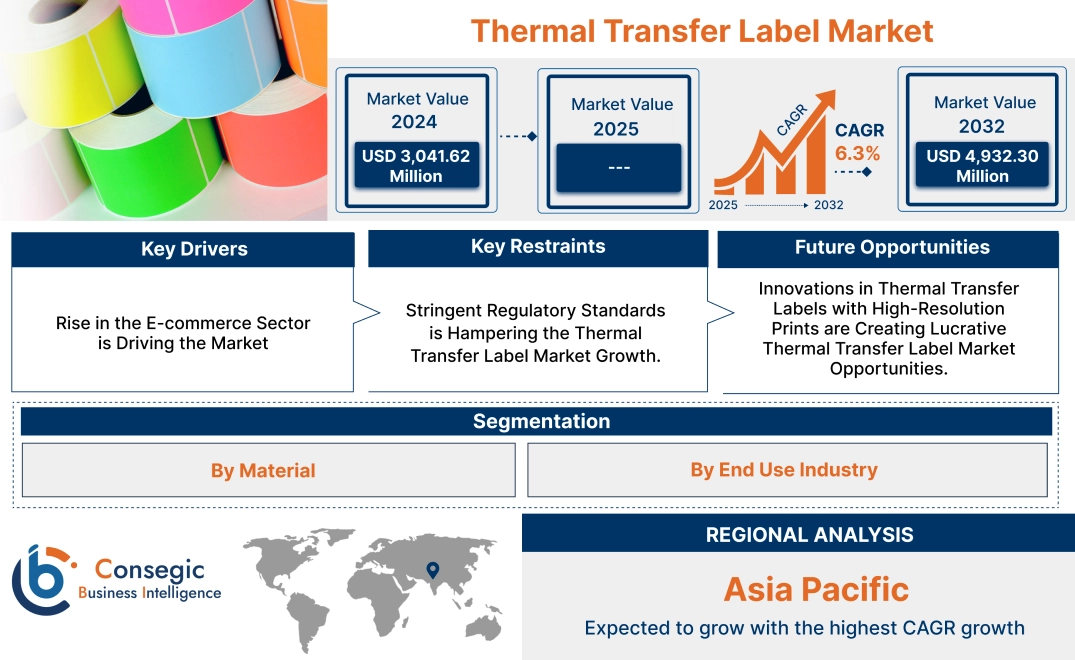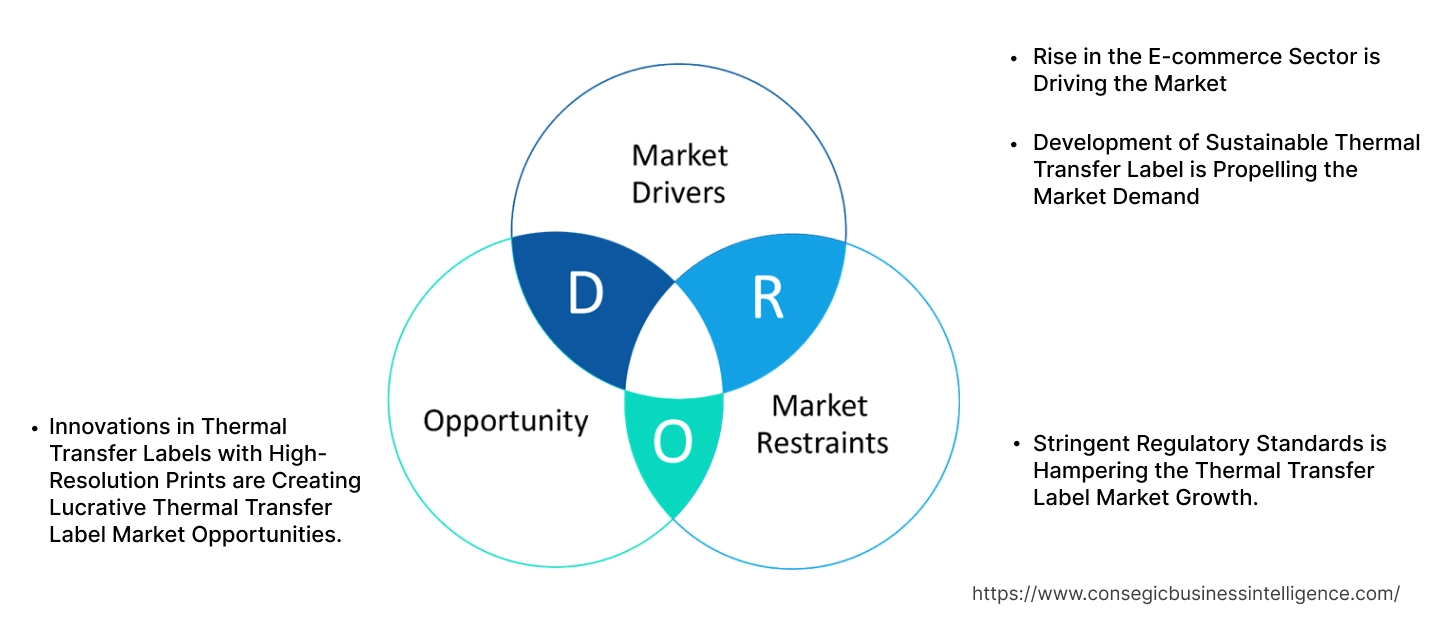- Summary
- Table Of Content
- Methodology
Thermal Transfer Label Market Size:
Thermal Transfer Label Market size is growing with a CAGR of 6.3% during the forecast period (2025-2032), and the market is projected to be valued at USD 4,932.30 Million by 2032 from USD 3,041.62 Million in 2024.
Thermal Transfer Label Market Scope & Overview:
A thermal transfer label is developed using a thermal transfer printing method that utilizes heat to transfer the ink from the ribbon into the label material to form the desired image or text. They offer high-quality prints with clear, sharp, and detailed text and images. This method ensures high durability, making them suitable for long-term applications where the label withstands hard conditions such as heat, chemicals, moisture, and abrasion. The material used for these labels generally consists of paper, polyester, polypropylene, polyvinyl chloride, and others. The end user industry includes food & beverages, pharmaceutical, logistics & transportation, industrial goods, electronics, and others
Key Drivers:
Rise in the E-commerce Sector is Driving the Market
The rise in the e-commerce sector has influenced the use of thermal labels for the development of shipping labels. The rise in online shopping has led to the use of reliable and efficient order fulfillment solutions such as high-quality and easily readable shipping labels. The thermal transfer paper offers advanced properties such as excellent durability, and smudging, which cater to the properties that are required for shipping labels. The rise in e-commerce influences the use of these labels for shipping label applications.
For instance,
- According to the article published by the India Brand Equity Foundation, in 2024, there was a rise in the e-commerce sector in India. The number of e-commerce orders increased by 36% compared to the previous year.
Thus, the rise in the e-commerce sector which leads to the use of shipping labels is driving the thermal transfer label market growth.
Development of Sustainable Thermal Transfer Label is Propelling the Market Demand
The rise in environmental concerns and increasing focus on sustainable solutions is encouraging consumers to opt for eco-friendly alternatives. Traditional label generally consists of non-recyclable materials which consist of adhesives and backing materials. However, advancement in materials has led to the development of recyclable labels which are generally made using recyclable content, compostable material, and biodegradable polymers.
For instance,
- In 2023, UPM Raflatac developed a novel total phenol-free thermal paper label that is made using 100% recycled fibers. These labels are attracting consumers seeking sustainable solutions, driving sales in the market.
Thus, based on the market analysis, the shift towards sustainable label solutions is driving the thermal transfer label market demand.
Key Restraints:
Stringent Regulatory Standards is Hampering the Thermal Transfer Label Market Growth.
Stringent regulatory standards enforced by government bodies pose constraints in the thermal transfer label market. These regulatory bodies are mainly focusing on environmental protection, consumer health, and product safety. These regulations focus on attributes including waste management, chemical restrictions, and consumer health. These regulations limit the use of certain chemicals that are used in inks and label materials.
Compliance with these regulations involves investment that is needed for research and development, documentation, and testing which increases the overall cost required for the production of thermal labels. Thus, stringent regulations and a rise in production costs are hindering the thermal transfer label market expansion.
Future Opportunities :
Innovations in Thermal Transfer Labels with High-Resolution Prints are Creating Lucrative Thermal Transfer Label Market Opportunities.
Innovations in thermal labels for high-resolution prints are creating lucrative opportunities for the market. The ability to print good-quality images, graphics, and small text with enhanced quality is enhancing the functionality of these labels across various industries. High-resolution printing allows to creation of visually appealing labels that generally enhance the identity of the brand, improve the presentation of the product, and provide consumers with precise information. This allows for the inclusion of barcodes, and QR codes which improve the product traceability. Manufacturers are developing labels that offer high-resolution prints.
For instance,
- In 2024, Kite Packaging introduced a new range of Thermal Labels. These labels are known to cater to both direct and thermal transfer labels. These labels offer high-resolution prints and have the ability to be in color.
Thus, the development of novel labels that offer high-resolution prints is creating lucrative thermal transfer label market opportunities.
Thermal Transfer Label Market Segmental Analysis :
By Material:
Based on material, the market is categorized into paper, polyester, polypropylene, polyvinyl chloride, and others.
Trends in the Material:
- Rise in trend for synthetic materials such as polyester and polypropylene among others is becoming popular because of their durability and water resistance.
- There is a growing trend for recyclable materials such as paper-based thermal labels, as they meet various environmental regulations.
The paper segment accounted for the largest market share in 2024.
- Paper is the primary material used for the development of thermal labels because of its widespread availability.
- It is more affordable than other materials such as polyester, and polypropylene among others which makes it a cost-effective solution for various applications.
- Paper is an easily recyclable material, which aligns with the growing preference for eco-friendly and sustainable packaging solutions.
- Manufacturers are developing thermal transfer papers to enhance the application of thermal transfer.
- For instance, Ahlstrom developed Adercote Vellum TT which is a thermal transfer label paper that is designed for thermal transfer printing and is compatible with a wide range of thermal transfer ribbons.
- Thus, based on the market analysis, the rise in the use of paper as a raw material for the development of labels is propelling the thermal transfer label market trends.
The polypropylene segment is expected to grow at the fastest CAGR over the forecast period.
- Polypropylene (PP) offers enhanced properties that make it ideal for the development of thermal labels.
- They are known for their exceptional chemical resistance and moisture retention, which makes them appropriate solutions for environments where these labels are exposed to conditions such as chemicals, liquids, and moisture.
- They also offer good durability and flexibility which makes them susceptible to withstand transportation without tearing easily.
- Additionally, PP labels are cost-effective to produce, which makes them a viable option for a range of applications across numerous industries.
- Thus, as per the market analysis, the incorporation of PP as a material for the development of labels is influencing the thermal transfer label market expansion.
By End Use Industry:
Based on end use industry, the market is categorized into food & beverages, pharmaceutical, logistics & transportation, industrial goods, electronics, and others.
Trends in the End Use Industry:
- Growing trends for online shopping are influencing the use of thermal label for package tracking.
- Rise in the use of thermal labels that withstand moisture and freezing conditions for fresh and frozen food.
The food & beverages segment accounted for the largest thermal transfer label market share of 34.67% in the year 2024.
- The food and beverages sectors are one of the primary end use sectors of thermal labels.
- The food and beverages industries adhere to various regulations regarding the labeling of the products which generally require detailed information which consists of data such as batch tracking, date of expiration, and nutritional content.
- These labels are essential for these applications because of their exceptional properties such as resistance to smudge & fading and durability among others.
- The rise in the demand for ready-to-eat meals and beverages widely uses these labels for packaging, logistics, and easy traceability of the product.
- For instance, TechNova Imaging Systems (P) Limited developed NovaJet Thermal Transfer Barcode Labels that consist of self-adhesives. These labels find their applications in retail, logistics, and food and beverage sectors to easily trace the product.
- Thus, as per the market analysis, the aforementioned factors are influencing the thermal transfer label market trends.
The pharmaceutical segment is expected to grow at the fastest CAGR over the forecast period.
- In the pharmaceutical sector, these labels are essential in ensuring the safety of the patients and tracing products.
- They are utilized to deliver necessary information such as the name of the drug, dosage, batch number, patient information, and the date of expiration.
- These labels are essential in the pharmaceutical sector as they offer resistance to chemicals, and moisture, durability, and the ability to withstand sterilization processes.
- They offer clear labeling, even under harsh conditions, which ensures accurate administration of medication, and minimizes the risk of medication errors.
- Thus, based on the market analysis, the rise in the adoption of thermal labels in the pharmaceutical sector is influencing the growth of the segment.
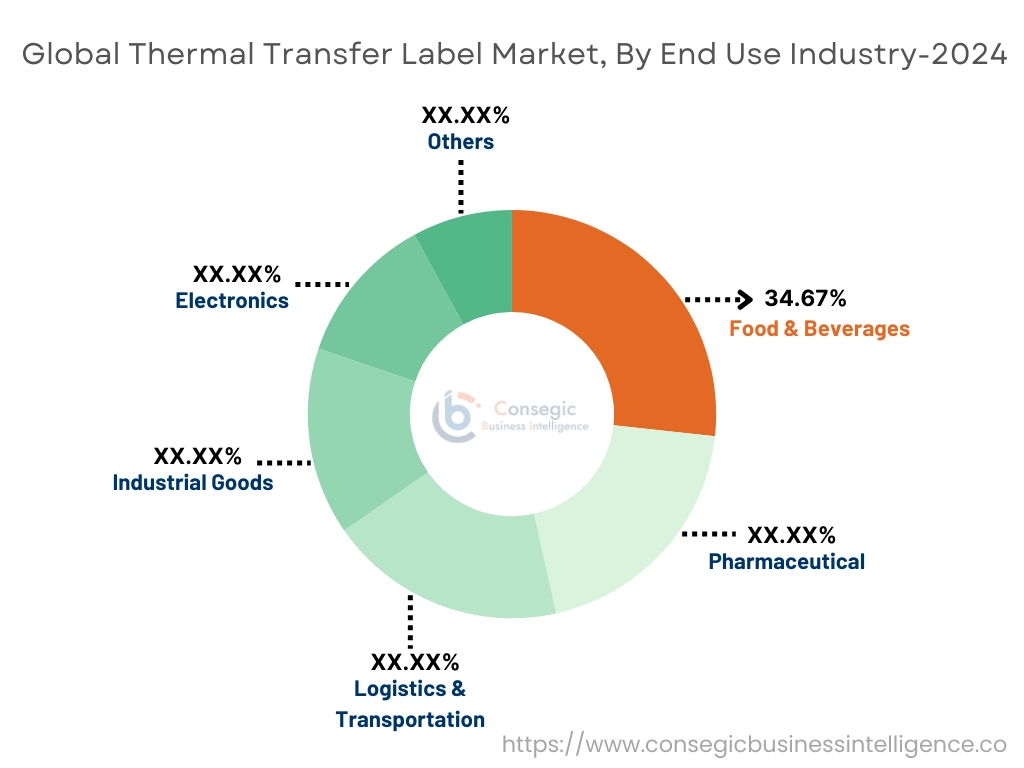
Regional Analysis:
The regional segment includes North America, Europe, Asia Pacific, the Middle East and Africa, and Latin America.
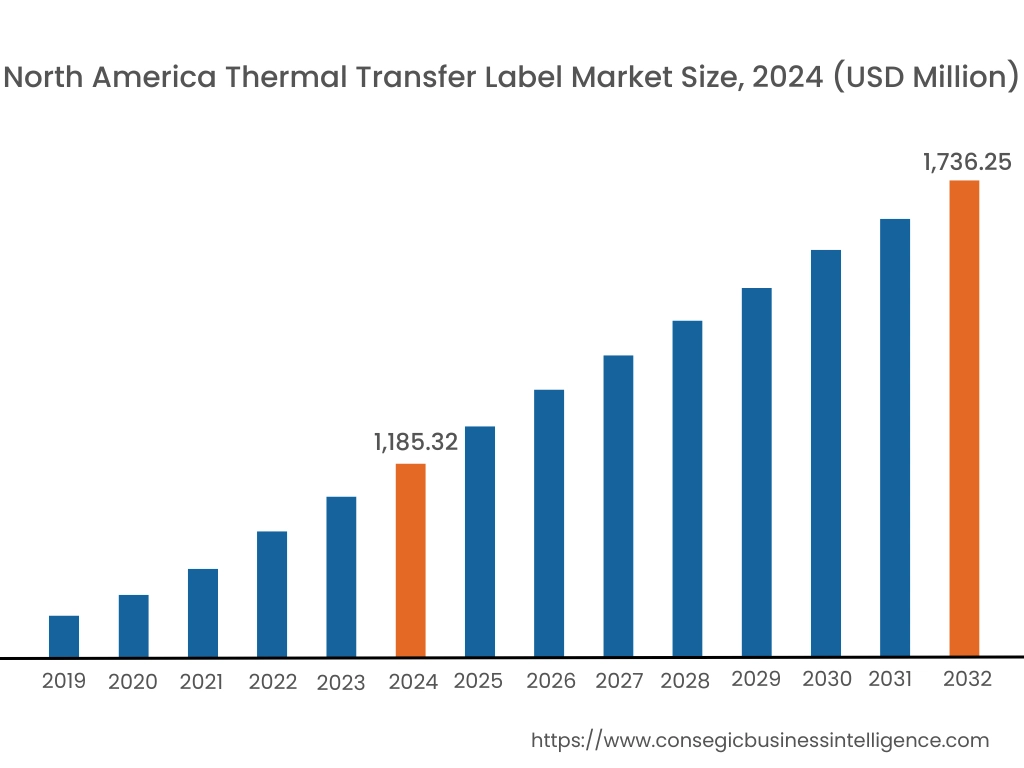
In 2024, North America accounted for the highest market share at 24.56% and was valued at USD 1,185.32 Million and is expected to reach USD 1,736.25 Million in 2032. In North America, the U.S. accounted for the highest market share of 71.45% during the base year of 2024. The North America region is witnessing a rise in the e-commerce sector, which drives the demand for shopping labels, and barcodes among others for proper management and handling of goods during transit. These labels are important for tracking the order and offering seamless delivery, which enhances the satisfaction of the customers. The rise in e-commerce sales led to the growing use of these labels.
For instance,
- According to the data published by the S. Department of Commerce, in 2024, states that the total e-commerce retail sales is observed to be USD 1,849.9 billion in the third quarter of 2024 with an increase of 1.3% from the second quarter of 2024.
According to the thermal transfer label market analysis, the region additionally has a strong presence of top manufacturers. These manufacturers are known to develop novel materials along with new printing technologies and label applications, thus driving market development.
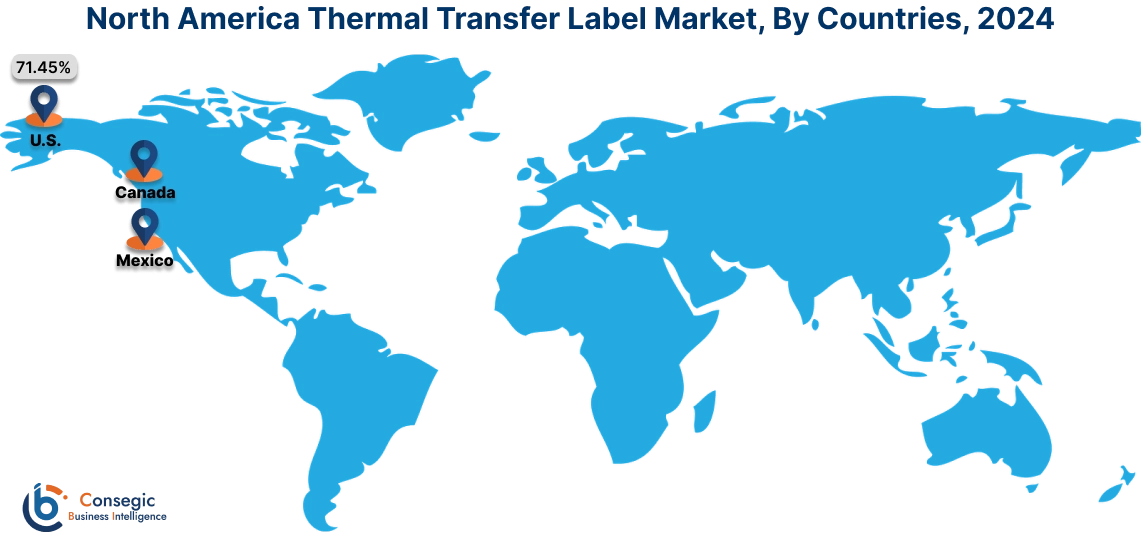
Asia Pacific is experiencing the fastest growth with a CAGR of 8.7% over the forecast period. The Asia Pacific region is experiencing rapid economic growth, because of the rise in disposable income and increase in consumer spending. This has influenced the demand for consumer goods and services, leading to a rise in the production and distribution of goods. The rise in the industrial and manufacturing sectors in this region influences the requirement for these labels for better management of the product. These labels allow manufacturers to efficiently track the complete process starting from the raw material to completely finished goods. This includes tracking the components, monitoring various production stages, and ensuring the quality of the product. Thus, the aforementioned factors are influencing the market trends in the coming years,
Europe presents a significant contribution to the thermal transfer label market analysis. The European market is mature, creating advanced label solutions that cater to various applications. European consumers mainly focus on sustainable solutions that lead to the incorporation of recycled materials and eco-friendly adhesives that are used in the production of labels. Additionally, they follow stringent regulations that govern the utilization of chemicals that are present in ink and labeling materials. European companies are continuously introducing advanced materials such as inks and developing novel technologies that cater to market requirements. Hence, the rise in the preference for sustainable solutions along with the adherence to stringent regulations is influencing the thermal transfer label industry in this region.
The Middle East and Africa (MEA) region is witnessing notable thermal transfer label market demand characterized by significant potential. The MEA regions are experiencing rapid industrialization and urbanization, driving a rise in the consumption of packaged goods that influences the use of high-quality labeling solutions. Additionally, the rise in regional trade and logistics leads to the requirement for effective tracking and management, which is propelling the utilization of labels, barcodes, and other tracking solutions. The growing demand for consumer goods in the sector contributes to the utilization of high-quality and durable solutions. This creates potential for manufacturers to adopt advanced technologies such as the integration of smart labeling solutions, which is driving the growth of the market in this region.
Latin America is an emerging region in the thermal transfer label market share, with significant potential for innovation. The region is witnessing a surge in the manufacturing and retail sectors. The rise in the requirement for consumer products is influenced by the adoption of packaged food & beverages, which require labelling solutions. The rise in the emphasis on the supply chain efficiency and tracing of the product across various developing industries which mainly includes pharmaceuticals, food & beverages, and industrial goods, is influencing the use of these labels to correctly identify the product and offer enhanced tracking. Thus, these aforementioned factors are influencing market growth in this region.
Top Key Players and Market Share Insights:
The global Thermal Transfer Label market is highly competitive with major players providing precise products to the national and international markets. Key players are adopting several strategies in research and development (R&D) and product innovation to hold a strong position in the global Thermal Transfer Label market. Key players in the Thermal Transfer Label industry include-
- 3M (United States)
- Thermal transfer printer labels on rolls (United States)
- JK Labels (India)
- American Tape & Label Co (United States)
- ADAZON (United States)
- OMNI Systems LLC (United States)
- Honeywell International Inc (United States)
- Lintec Corporation (Japan)
- Lynx (United States)
- Zebra (United States)
Recent Industry Developments :
Product Launch:
- In 2024, Kite Packaging introduced a new range of Thermal Labels. These labels are known to cater to both direct and thermal labels. These labels offer high-resolution prints and have the ability to be in color.
- In 2023, Spinnaker Pressure Sensitive Products, LLC introduced a novel pressure-sensitive labeling solution mainly for thermal transfer. It is mainly designed to be used for shipping labels and print and dispensing solutions among other applications.
Thermal Transfer Label Market Report Insights :
| Report Attributes | Report Details |
| Study Timeline | 2019-2032 |
| Market Size in 2032 | USD 4,932.30 Million |
| CAGR (2025-2032) | 6.3% |
| By Material |
|
| By End Use Industry |
|
| By Region |
|
| Key Players |
|
| North America | U.S. Canada Mexico |
| Europe | U.K. Germany France Spain Italy Russia Benelux Rest of Europe |
| APAC | China South Korea Japan India Australia ASEAN Rest of Asia-Pacific |
| Middle East and Africa | GCC Turkey South Africa Rest of MEA |
| LATAM | Brazil Argentina Chile Rest of LATAM |
| Report Coverage |
|
Key Questions Answered in the Report
How big is the Thermal Transfer Label market? +
In 2024, the Thermal Transfer Label market is USD 3,041.62 Million.
Which is the fastest-growing region in the Thermal Transfer Label market? +
Asia Pacific is the fastest-growing region in the Thermal Transfer Label market.
What specific segmentation details are covered in the Thermal Transfer Label market? +
Material and End Use Industry segmentation details are covered in the Thermal Transfer Label market.
Who are the major players in the Thermal Transfer Label market? +
3M (United States), Thermal transfer printer labels on rolls (United States), and OMNI Systems LLC (United States) are some of the major players in the market.
